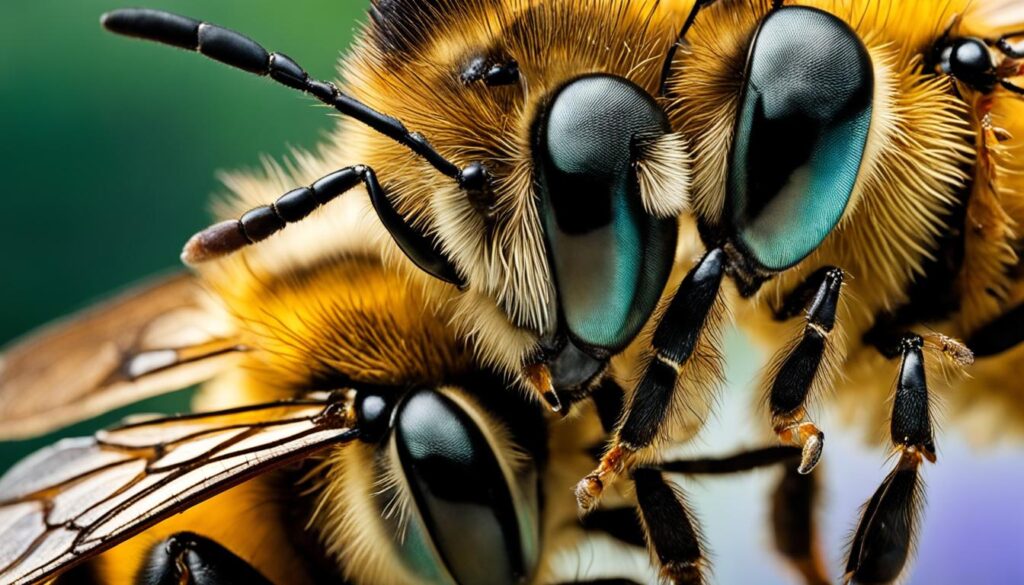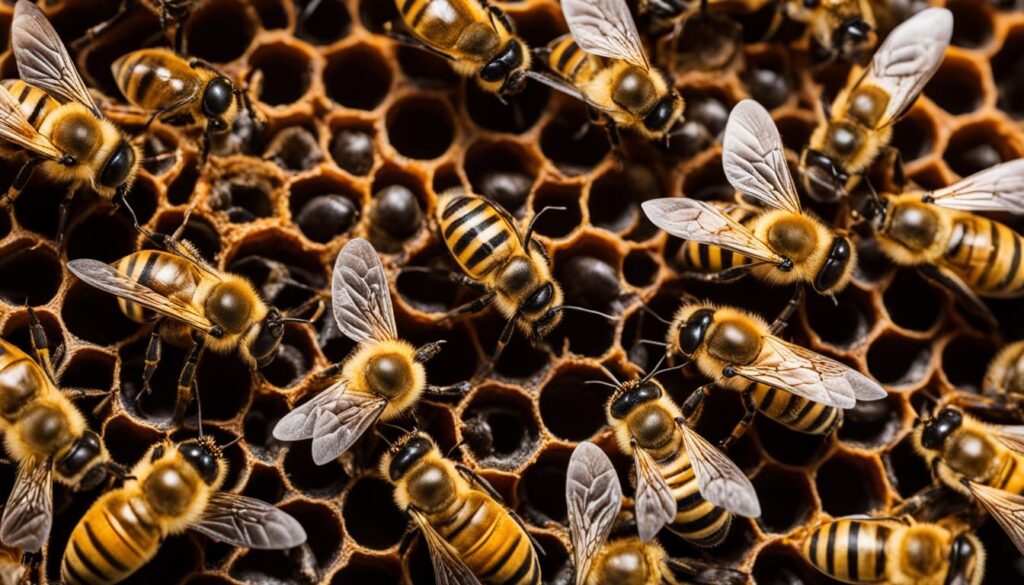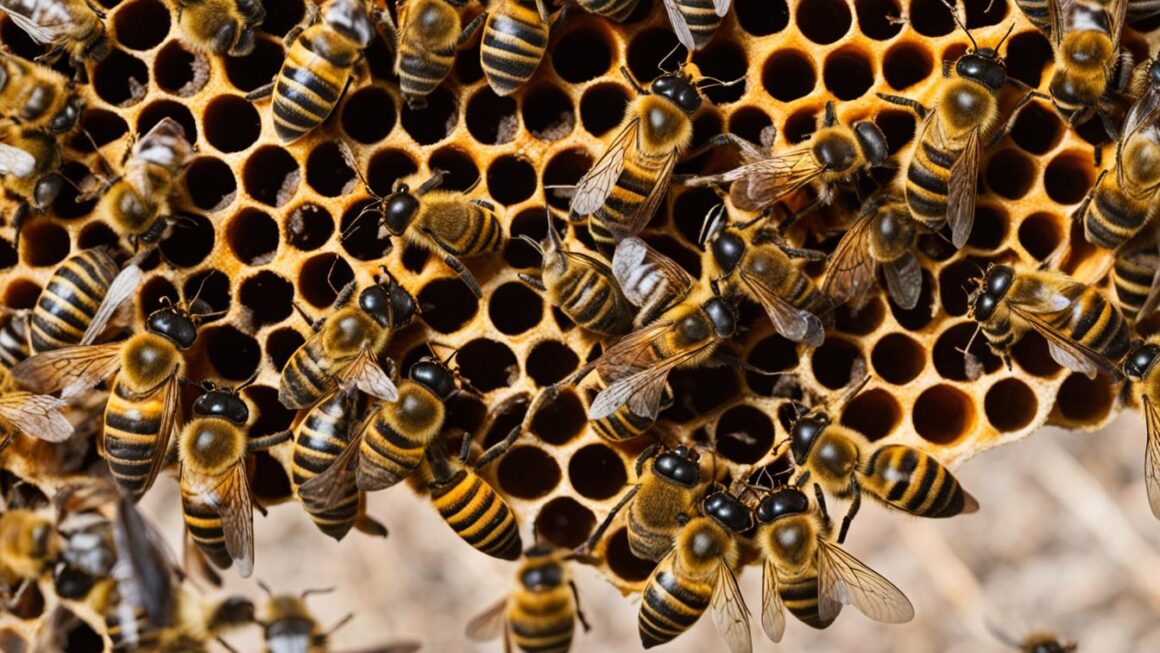In the world of bees, the queen bee is the most important member of the colony. Not only does she lead the hive, but she also has a vital role in the reproductive success of the colony. Queen bee mating behavior is complex and fascinating, and understanding it is crucial in understanding the overall health and genetic diversity of the bee population.
So who does the queen bee mate with? Let’s explore the partners of the monarch and delve into the intricate world of bee mating behavior.
Key Takeaways
- Queen bees play a crucial role in the hive’s reproductive success and genetic diversity.
- The queen bee mates with multiple drones during a mating flight to ensure genetic diversity in the colony.
- Drones are male bees specifically designated for mating purposes.
- Understanding queen bee mating behavior and genetics is essential for sustaining bee populations and promoting ecosystem health.
The Role of the Queen Bee in the Colony
Before we delve into the fascinating world of queen bee mating, let’s first understand the critical role that the queen bee plays in the bee colony. The queen bee is the leader and reproductive powerhouse of the colony, responsible for laying eggs and ensuring the survival of the hive.
The queen bee is the only fertile female in the colony, capable of laying up to 2,000 eggs per day. These eggs hatch into either worker bees, drones, or new queens. The nurse bees in the colony care for and feed the developing larvae, ensuring the survival and growth of the colony.
Without the queen bee, the colony would eventually perish. The worker bees, responsible for foraging and maintaining the hive, would be unable to reproduce, and the colony would cease to exist.
The queen bee is the leader and reproductive powerhouse of the colony, responsible for laying eggs and ensuring the survival of the hive.
Mating Behavior of Queen Bees
Queen bees engage in a highly specific mating behavior to ensure the genetic diversity of the colony. During the mating flight, the queen bee leaves the colony and flies to a drone congregation area, a location where drones from different colonies gather to mate with the queen. Once there, the queen bee mates with multiple drones, typically between 12 to 15, to obtain enough sperm for future egg-laying. The drones that mate with the queen bee come from other colonies, ensuring diverse genetics within the bee population.
The queen bee’s mating behavior is a critical aspect of the bee colony’s survival and genetic diversity. Without the genetic diversity provided by the queen bee’s mating flight, the bee colony could experience reduced adaptability and resilience. This could lead to reduced fitness and survival rates, ultimately affecting the overall health of the colony.
“During the mating flight, the queen bee leaves the colony and flies to a drone congregation area, a location where drones from different colonies gather to mate with the queen.”
The Anatomy of Drones
Understanding the anatomy of drones is crucial in unraveling the queen bee’s mating partners. Drones are male bees specifically designated for mating purposes. They are larger in size than worker bees and have larger eyes. Drones have a slightly different anatomy than worker bees, with larger wings, a larger thorax, and a more robust abdomen.
The drone’s reproductive system is also unique. They have larger testicles and seminal vesicles that allow them to produce and store sperm. When a drone mate with a queen bee, they transfer their sperm to the queen’s sperm storage organ through their endophallus. The endophallus is then torn off, resulting in the drone’s death.
As mentioned before, drones play a vital role in the queen bee’s mating process. By mating with drones from other colonies, the queen bee ensures the genetic diversity of the colony, contributing to the survival and adaptability of the bee population. Bee genetics is a complex yet essential aspect of the queen bee mating behavior, and understanding the anatomy of drones helps us comprehend it better.
Mating Process of Queen Bees
Queen bees engage in a unique mating process with their partners that involves pheromones and sacrifice on the part of the drones. During the mating flight, the queen bee flies around until drones from other colonies detect her pheromones and follow her. The drones then try to mate with the queen bee while in flight. The queen bee can mate with multiple drones at once while in mid-air.
Once a drone successfully mates with the queen bee, its reproductive organs are torn off, resulting in its death. This brutal sacrifice ensures that the drones from different colonies compete for mating opportunities, increasing genetic diversity within the bee population.

After the mating process is complete, the queen bee stores the sperm from her partners in her sperm storage organ. This stored genetic material will last for the queen’s entire life span, allowing her to lay eggs with a mixture of genetic traits from different drones. This genetic diversity is essential for the overall health and survival of the bee colony.
The intricate and specific mating process of the queen bee ensures the genetic diversity and survival of the bee colony. It also highlights the importance of bees in our ecosystem and the role they play in maintaining biodiversity.
Mating Frequency and Success
The frequency and success of queen bee mating have a crucial impact on the colony’s reproduction and overall health. The queen bee needs to mate only once in her lifetime to store enough sperm to fertilize eggs throughout her productive years.
However, there are several factors that can affect her mating success, including unfavorable weather conditions, poor-quality drones, or insufficient food supply. If the queen bee does not mate successfully, she will not be able to lay fertilized eggs, which can lead to the colony’s decline.
On the other hand, a successful mating flight ensures genetic diversity within the colony and can result in a more resilient and adaptable population. The queen bee may engage in multiple mating flights to increase the chances of successful fertilization, but each mating flight comes with its risks, and the queen bee may be vulnerable to predators or adverse weather conditions.
In conclusion, the queen bee’s mating frequency and success are crucial for the colony’s reproduction and genetic diversity. A successful mating flight ensures a healthy and resilient population, while an unsuccessful one can lead to the colony’s decline.
The Genetics behind Queen Bee Mating
The queen bee’s mating behavior plays a crucial role in bee genetics, impacting the colony’s genetic diversity and resilience. During the mating flight, the queen bee mates with multiple drones, storing their genetic material in her sperm storage organ.
This genetic diversity ensures that the colony can adapt to changing environmental conditions and resist diseases and pests. It is also vital for maintaining the colony’s productivity and reproductive success.
| Factors Affecting Genetic Diversity | Impacts on the Colony |
|---|---|
| Queen bee’s mating behavior | Influences genetic diversity and colony resilience |
| Bee genetics | Impacts bee behavior, productivity, and colony success |
| Honeybee mating | Plays a crucial role in bee reproduction and the colony’s health |
In conclusion, the genetics behind queen bee mating is a complex and fascinating topic that highlights the importance of genetic diversity for bee colonies. By understanding the factors that affect genetic diversity, we can better appreciate the critical role that bees play in our ecosystems and the impact they have on our food supply.

The Fate of Unmated Queen Bees
Despite the importance of queen bee mating behavior, some queen bees may remain unmated due to various factors. Unfavorable weather conditions, a lack of suitable drones, or other environmental factors can prevent successful mating.
Unmated queen bees have limited reproductive capabilities, which can cause problems for the colony if left unchecked. The colony may not have enough workers to support the queen bee’s egg-laying, resulting in a weakened or unsustainable hive.
If the queen bee remains unmated for an extended period, the colony may replace her with a new queen. The new queen bee will emerge from a specially constructed cell, and the old queen will either leave or be forced out of the hive.
It’s crucial to monitor queen bee mating behavior to ensure the continued success and health of the colony. Beekeepers can take steps to increase the chances of successful mating, such as providing enough drones and ensuring favorable weather conditions during the queen’s mating flight.
Image related to the Fate of Unmated Queen Bees:
Conclusion
The queen bee’s mating behavior is an essential aspect of the bee colony’s survival and genetic diversity. Understanding who the queen bee mates with, her mating behavior, and the importance of genetic diversity helps us appreciate the intricate world of bee reproduction and its role in sustaining our ecosystem.
As the leader and reproductive powerhouse of the colony, the queen bee plays a vital role in ensuring the survival of the hive. Her highly specific mating behavior helps maintain healthy and diverse genetics within the bee population. The drones, designated for mating purposes, have a unique anatomy that enables them to compete for mating opportunities and increase the genetic diversity of the colony.
The success of the mating process impacts the queen bee’s reproductive capacity and the overall health of the colony. Mated queen bees, with a diverse genetic pool, can lay eggs with a mixture of genetic traits. In contrast, unmated queens have limited reproductive capabilities and are typically replaced by the colony.
Overall, the genetics behind queen bee mating are crucial for the colony’s resilience and adaptability. The queen bee’s mating behavior and partners are fascinating topics that shed light on the intricate world of insect reproduction and the importance of bees in sustaining our ecosystem.
FAQ
Who does the queen bee mate with?
The queen bee mates with multiple drones from other colonies during her mating flight.
What is the role of the queen bee in the colony?
The queen bee is the leader and reproductive powerhouse of the bee colony. She is responsible for laying eggs and ensuring the survival of the hive.
What is the mating behavior of queen bees?
Queen bees engage in a specific mating behavior where they mate with multiple drones from other colonies during a mating flight, ensuring genetic diversity within the bee population.
What is the anatomy of drones?
Drones are male bees designated for mating purposes. They are larger in size than worker bees and have larger eyes.
How does the queen bee mating process work?
During the mating flight, the queen bee attracts drones with pheromones. Once a drone mates with the queen bee, its reproductive organs are torn off, resulting in its death.
How often does a queen bee need to mate?
A queen bee only needs to mate once in her lifetime to store enough sperm for future egg-laying. However, she may engage in multiple mating flights to ensure genetic diversity.
What is the impact of queen bee mating on genetics?
Queen bee mating significantly impacts bee genetics. The genetic material from different drones is stored within the queen’s sperm storage organ, allowing her to lay eggs with a mixture of genetic traits.
What happens to unmated queen bees?
Unmated queen bees have limited reproductive capabilities and are typically replaced by the colony when a new queen emerges.
What is the importance of queen bee mating for the colony?
Queen bee mating is crucial for the survival and genetic diversity of the bee colony. It helps maintain healthy genetics and ensures the adaptability of the colony.




